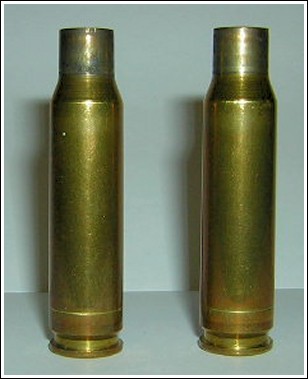This picture shows the first sign of case head separation on two fired
.308 Winchester cases. Notice the bright horizontal ring near the base of these cases. This is a common problem for handloaders, when
cases don't resized properly. Avoiding this symptom often means going beyond just reading the instructions that come with resizing dies.
Case head separation is caused when the case shoulder gets pushed back a few thousandths of an inch too far during the resizing operation. If you measure your
cases (at the shoulder), this can be avoided by setting your die height more accurately.

If you ever experience this warning sign of case head separation take it seriously, and throw those cases away.
The next firing would definitely split these cases in two, leaving most of the case stuck in your chamber. The escaping gases can blow back
through the bolt, and cause serious injuries.
If you handloads have no chamber clearance (at the shoulder), your handloads might not chamber properly. If the case shoulder gets
pushed back too far, your handloads will be too short for your chamber. When a short case is fired, its shoulder is blown forward until it fills up the
chamber. This stretches a case just above the web (the solid part of your case). At this point the case becomes paper thin, and it's wasted.
These cases could have been used for many more loadings if they had been measured and accurately resized at the shoulder during the reloading process.
Until now, hardloaders have used several different methods of measuring chamber clearance. These methods include coating a resized
case with soot from a candle or using a Magic Marker, and then chambering it to see where it contacts the chamber.
